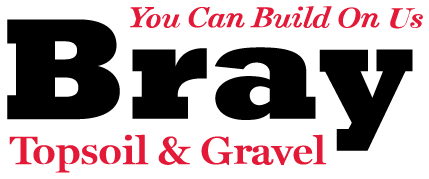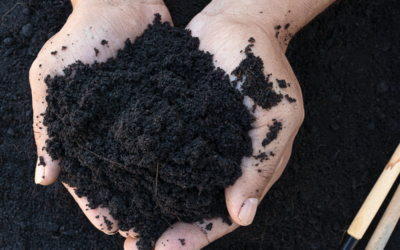 Soils harbor some of the most diverse microbes on Earth and are essential for both nutrient cycling and carbon storage. Topsoil is created naturally through a slow process of weathering rocks and decaying organic matter. It takes around 100 years for every inch to be formed. The majority of plants get most of their roots because of this organic matter. The topsoil layer is a mixture of sand, silt, clay, and broken-down organic matter, called humus. Humus is a rich, highly decomposed organic matter mostly made from dead plants, crunched-up leaves, dead insects, and twigs. Topsoil is the home of living things and the materials that they make or they change. It depends on the area where you live weather the topsoil is alkaline or acidic. A good quality of topsoil has a pH value of 5.5 and 7.5.
Soils harbor some of the most diverse microbes on Earth and are essential for both nutrient cycling and carbon storage. Topsoil is created naturally through a slow process of weathering rocks and decaying organic matter. It takes around 100 years for every inch to be formed. The majority of plants get most of their roots because of this organic matter. The topsoil layer is a mixture of sand, silt, clay, and broken-down organic matter, called humus. Humus is a rich, highly decomposed organic matter mostly made from dead plants, crunched-up leaves, dead insects, and twigs. Topsoil is the home of living things and the materials that they make or they change. It depends on the area where you live weather the topsoil is alkaline or acidic. A good quality of topsoil has a pH value of 5.5 and 7.5.
Types Of Topsoil
There are six main soil groups: clay, sandy, silty, peaty, chalky, and loamy. They each have their own unique properties.
Below, we will describe each type of topsoil to help you decide which type to use for your particular need.
- Clay soil – Clay Soil is a heavy soil type that benefits from high nutrients. Clay soils remain wet and cold in winter and dry out in summer. These soils are made of over 25 percent clay, and because of the spaces found between clay particles, clay soils hold a high amount of water. The best plants for clay soil are trees and the hardy varieties of perennials.
- Sandy soil – Sand is a naturally occurring granular material composed of finely divided rock and mineral particles. A soil containing more than 85% sand-sized particles by mass is called sandy. It is quicker to warm up than clay soil and tends to dry out in the summer. It is best to use a sandy soil for plants that do not need lots of water. Examples of these types of plants are evergreens and sumac.
- Peaty soil – Peat soil consists largely of peat and is consequently rich in humus and of acid reaction. Peaty soil is available to retain a large amount of moisture. It is rare to find peat soil in a garden that needs to be imported. It is unique to natural areas called peatlands, bogs, mires, moors, or muskegs. Because of its low pH, peat moss is very suitable for vegetables and fruits that require an acidic environment. These include blueberries, pieris, heathers, azaleas, camellias, tomatoes, and so on.
- Silty soil – Silt soil is a light and moisture retentive soil type with a high fertility rating. As silt soils compromise medium sized particles, they are well drained and hold moisture well. As the particles are fine, they can be easily compacted and are prone to washing away with rain. It drains poorly but is considered to be among the most fertile of soils. Roses grow well in silt because they prefer soil on the heavy side.
- Chalky soil – Chalky soils are often shallow, stony, and free-draining. Added organic matter can decompose rapidly, making them difficult to keep fertile. Poor growth and yellowing leaves (chlorosis) are a result of the plants not being able to absorb iron and manganese by their roots. Chalky soil is always highly alkaline. To test your soil, take a small piece and drop it into a jar of vinegar. If it froths up, the soil is alkaline. Most climbing plants are perfect for growing over outbuildings, walls, fences or for creating a feature by growing over pergolas or arches and do well in chalky soil.
- Loamy soil – Loam is soil composed mostly of sand, silt, and a smaller amount of clay and is not strictly a soil of its own. Loam soil is often viewed as the ideal soil because it is a mixture and avoids the negative of each of its components. It drains well and allows air to move freely between particles down to the roots. Flower bulbs that grow well in loam soils include snowdrops, anemones, grape hyacinths, lilies, and daffodils.
Whatever your soil type, there are plants that will thrive and look absolutely gorgeous in your garden.
Uses For Topsoil
Topsoil is a good choice for filling up raised beds, repairing eroded spots, or filling in holes. When planting a new lawn or overseeding a patchy lawn, you can use a thin layer of topsoil to protect grass seeds as they sprout. One thing you shouldn’t use topsoil for is filling your containers. Mixing topsoil with existing soil helps to create a transition layer that helps to prevent drainage problems between the two soil types. Mix compost with topsoil to create your potting compost which is the tactic that many nurseries do because it combines the advantages of soil with the benefits of compost.
Different Grades Of Topsoil
You may already have rich, natural topsoil ready for planting, but if you do not, all grades of topsoil are available in bags and in bulk from commercial suppliers.
The three grades of topsoil are premium, general purpose, and economy.
- Economy grade – Economy topsoil is a screened, cost-effective aggregate used by professional landscapers and casual gardeners alike who need a cheap fill soil in projects where there is not a need for higher grades of soil.
- General purpose grade – General purpose topsoil is suitable for landscaping and shrubbery. Unlike economy grade soil, it will have undergone a screening process so that it is suitable to grow plants and flowers. It is sold in different screen size grades that are based on the maximum particle size. General purpose topsoil is suitable for good agriculture and horticulture, as a base for new lawns, and for some new plant beds. The finer screen size grades are useful for top dressing lawns, while the coarser grades are ideal for sod and turf laying.
- Premium grade – Premium grade topsoil is the most expensive of the three grades and has a good structure and a loamy texture, it is made up of sand, clay, and organic materials. If you want to grow vegetables or flowers for show, you should use the top-quality topsoil which is rich in nutrients. It should be free of any weed seeds and known as certified soil.
Improving Your Soil Type
As an alternative to buying better topsoil, you can try to improve your existing topsoil by adding soil improvers and organic compost. Your soil, any soil, is made up of a combination of up to six components. In a perfect world, it has roughly equal parts of sand, silt and clay, plus air, water, and a small amount of organic matter (usually less than five percent, often much less.) But since you and I don’t live in that world, we likely don’t have perfect soil either. The good news is that conditions can be improved to make your soil more hospitable to the plants you want to grow there. Get a soil testing kit to see what type of soil you have. Once you know your soil type you will be able to add the proper nutrients to improve your particular soil.
Request a Quote (859-635-5680) And We Will Contact You Shortly!
Calculate How Much Material You Need For Your Project

About Bray Topsoil & Gravel
Topsoil and gravel delivered to you by Bray Trucking, a specialized aggregate hauler servicing the Kentucky, Ohio, and Indiana region.
>>Learn More




